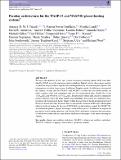Files in this item
Peculiar architectures for the WASP-53 and WASP-81 planet-hosting systems
Item metadata
| dc.contributor.author | Triaud, Amaury H. M. J. | |
| dc.contributor.author | Neveu-VanMalle, Marion | |
| dc.contributor.author | Lendl, Monika | |
| dc.contributor.author | Anderson, David R. | |
| dc.contributor.author | Collier Cameron, Andrew | |
| dc.contributor.author | Delrez, Laetitia | |
| dc.contributor.author | Doyle, Amanda | |
| dc.contributor.author | Gillon, Michaël | |
| dc.contributor.author | Hellier, Coel | |
| dc.contributor.author | Jehin, Emmanuël | |
| dc.contributor.author | Maxted, Pierre F. L. | |
| dc.contributor.author | Ségransan, Damien | |
| dc.contributor.author | Smalley, Barry | |
| dc.contributor.author | Queloz, Didier | |
| dc.contributor.author | Pollacco, Don | |
| dc.contributor.author | Southworth, John | |
| dc.contributor.author | Tregloan-Reed, Jeremy | |
| dc.contributor.author | Udry, Stéphane | |
| dc.contributor.author | West, Richard | |
| dc.date.accessioned | 2017-03-15T12:30:11Z | |
| dc.date.available | 2017-03-15T12:30:11Z | |
| dc.date.issued | 2017-05 | |
| dc.identifier | 249376919 | |
| dc.identifier | e0d33888-cd1c-4873-9b0e-e845923eff0c | |
| dc.identifier | 85018289273 | |
| dc.identifier | 000398416700034 | |
| dc.identifier.citation | Triaud , A H M J , Neveu-VanMalle , M , Lendl , M , Anderson , D R , Collier Cameron , A , Delrez , L , Doyle , A , Gillon , M , Hellier , C , Jehin , E , Maxted , P F L , Ségransan , D , Smalley , B , Queloz , D , Pollacco , D , Southworth , J , Tregloan-Reed , J , Udry , S & West , R 2017 , ' Peculiar architectures for the WASP-53 and WASP-81 planet-hosting systems ' , Monthly Notices of the Royal Astronomical Society , vol. 467 , no. 2 , pp. 1714-1733 . https://doi.org/10.1093/mnras/stx154 | en |
| dc.identifier.issn | 0035-8711 | |
| dc.identifier.other | BibCode: 2017MNRAS.tmp..167T | |
| dc.identifier.other | ORCID: /0000-0002-8863-7828/work/58531344 | |
| dc.identifier.uri | https://hdl.handle.net/10023/10470 | |
| dc.description.abstract | We report the detection of two new systems containing transiting planets. Both were identified by WASP as worthy transiting planet candidates. Radial velocity observations quickly verified that the photometric signals were indeed produced by two transiting hot Jupiters. Our observations also show the presence of additional Doppler signals. In addition to short-period hot Jupiters, we find that the WASP-53 and WASP-81 systems also host brown dwarfs, on fairly eccentric orbits with semimajor axes of a few astronomical units. WASP-53c is over 16 MJupsin ic and WASP-81c is 57 MJupsin ic. The presence of these tight, massive companions restricts theories of how the inner planets were assembled. We propose two alternative interpretations: the formation of the hot Jupiters within the snow line or the late dynamical arrival of the brown dwarfs after disc dispersal. We also attempted to measure the Rossiter–McLaughlin effect for both hot Jupiters. In the case of WASP-81b, we fail to detect a signal. For WASP-53b, we find that the planet is aligned with respect to the stellar spin axis. In addition we explore the prospect of transit-timing variations, and of using Gaia's astrometry to measure the true masses of both brown dwarfs and also their relative inclination with respect to the inner transiting hot Jupiters. | |
| dc.format.extent | 8246058 | |
| dc.language.iso | eng | |
| dc.relation.ispartof | Monthly Notices of the Royal Astronomical Society | en |
| dc.subject | Planetary systems | en |
| dc.subject | Planets and satellites: individual: WASP-81 | en |
| dc.subject | WASP-53 | en |
| dc.subject | Binaries: eclipsing | en |
| dc.subject | Brown dwarfs | en |
| dc.subject | QB Astronomy | en |
| dc.subject | QC Physics | en |
| dc.subject | 3rd-DAS | en |
| dc.subject.lcc | QB | en |
| dc.subject.lcc | QC | en |
| dc.title | Peculiar architectures for the WASP-53 and WASP-81 planet-hosting systems | en |
| dc.type | Journal article | en |
| dc.contributor.sponsor | Science & Technology Facilities Council | en |
| dc.contributor.institution | University of St Andrews. School of Physics and Astronomy | en |
| dc.contributor.institution | University of St Andrews. St Andrews Centre for Exoplanet Science | en |
| dc.identifier.doi | 10.1093/mnras/stx154 | |
| dc.description.status | Peer reviewed | en |
| dc.identifier.url | http://adsabs.harvard.edu/abs/2017MNRAS.tmp..167T | en |
| dc.identifier.grantnumber | ST/M001296/1 | en |
This item appears in the following Collection(s)
Items in the St Andrews Research Repository are protected by copyright, with all rights reserved, unless otherwise indicated.

